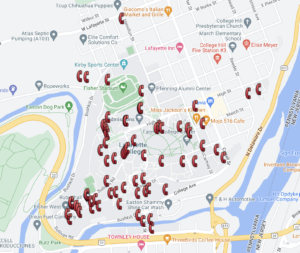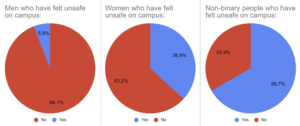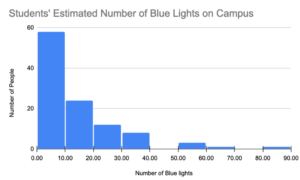Our team interviewed Lafayette College’s Director of Public Safety and the Executive Director of Facility Operations. Key takeaways included:
- Blue-light emergency phones are not used for emergencies. There has never been a legitimate emergency call made from a blue-light phone at Lafayette.
- Lafayette’s strategy for campus safety is redundancy. The college believes that overlapping safety measures best provide outcomes.
- Blue-light emergency phones are important for the feeling of safety they provide, especially to parents.
- Our solution could use internal radio channels to communicate with Public Safety.
- There are 72 blue-light emergency phones on campus, as seen below: [1]

We were surprised by the number and location of blue-light emergency phones. Based on this information, we decided to survey current Lafayette College students on their familiarity with the blue-light system on campus and their perspectives on safety..Respondents discussed specific areas of Lafayette’s campus as well as existing safety systems. The blue-light emergency phone system was popularized after the Clery Act was passed in 1990. Since then, universities have been required to track crimes on their campuses and publicly release an annual security report in order to continue receiving federal financial aid funding [1].
On many campuses, the presence of blue lights drastically changed crime patterns. For example, Rice University in Houston, Texas had a long history of criminal incidents and a crime [5] rate similar to the city of Houston’s prior to their system’s installation. ”However, after Rice completed the installation of 80 blue light emergency phones in 2010 … the overall crime rate on campus decreased despite the city of Houston’s crime rate remaining high [2]. Specifically, on-campus burglaries plummeted by 67.74%.” Our team recognizes the powerful impact on campus safety that blue lights can have, but we also acknowledge the shortcomings of existing systems, and seek to address these areas for improvement.
One lesson we have learned from students at Lafayette College, a particularly accessible subset of stakeholders, is that the perception of blue lights and emergency safety systems does not align with their actual presence. Students greatly underestimate the number of blue lights at their disposal, note the system’s outdated features, and find the units difficult to use.
Survey Results:
We surveyed 111 current students on their opinions of safety and the blue-light emergency system. About 23% of students reported that they had felt unsafe on campus, although the responses greatly differed based on gender identity.

Most respondents reported basic awareness and understanding of the blue-light system as well as knowledge the location of at least one blue-light emergency phone. However, in aggregate, students were uninformed about blue-light emergency phone locations and the number that exist on campus. According to Lafayette College’s Director of Public Safety, there are currently 72 blue-light emergency phones on campus, but surveyed students struggled to locate more than a few blue-lights, and the majority of students believe there to be fewer than 10.

In addition to the collected survey data from our stakeholders, we have reached out to the Lafayette Psychology department to further our understanding on the impact of student perspective on actual safety around campus. According to previous studies, it turns out that students reporting on the perceived safety of a particular area on a university campus were influenced not only by events that had taken place in the past, but also measured that had been taken to combat these events [3][4]. We are already putting this information into use planning our future steps and we will continue to seek our more perspectives from our stakeholders.
References
[1] Google my maps. [Online]. Available: https://www.google.com/maps/d/u/0/viewer?msa=0&ie=UTF8&t=m&ll=40.69961008110216%2C-75.20830747413075&spn=0.005694%2C0.013304&z=16&source=embed&mid=1Zn8mN0xsufTNTZ3pUR7CRRdRpSs. [Accessed: 08-Dec-2022].
[2] “Blue-light emergency phones on campus: Media … ,” Blue-light emergency phones on campus: Media infrastructures of feeling. [Online]. Available: https://journals.sagepub.com/doi/10.1177/1367877918820336. [Accessed: 08-Dec-2022].
[3] G. Authors, “Despite decline in usage, blue light emergency phones are here to stay,” Campus Safety Magazine, 16-Dec-2020. [Online]. Available: https://www.campussafetymagazine.com/university/blue-light-emergency-phones/. [Accessed: 08-Dec-2022].
[4] D. Huang, V. Ceccato, and M. Kyttä “Safety perceptions in university campuses: The role of environment – crime prevention and community safety,” SpringerLink, 01-Jun-2022. [Online]. Available: https://link.springer.com/article/10.1057/s41300-022-00148-y. [Accessed: 29-Nov-2022].
[5] Campus Safety, “Crime archives,” Campus Safety Magazine, 11-Nov-2022. [Online]. Available: https://www.campussafetymagazine.com/tag/crime/. [Accessed: 08-Dec-2022].